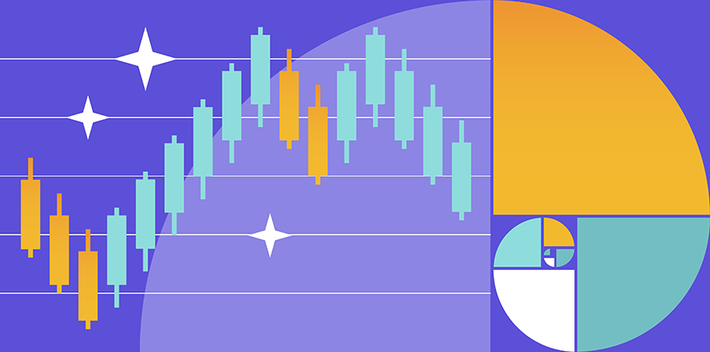Fibonacci retracement is a powerful tool that traders use to identify potential reversal points in the forex market. It is based on the famous Fibonacci sequence, a mathematical pattern that appears in various aspects of nature and financial markets. By applying Fibonacci retracement levels to price movements, traders can predict where corrections may end and trends may resume. In this article, we’ll explore how to use Fibonacci retracement in forex trading, its significance, and best practices for maximizing its effectiveness.
Understanding Fibonacci Retracement in Forex Trading
Fibonacci retracement is a technical analysis tool that helps traders identify support and resistance levels by measuring the size of a previous price move. It is built on key Fibonacci ratios: 23.6%, 38.2%, 50%, 61.8%, and 78.6%. These levels indicate potential areas where price corrections may pause before resuming the prevailing trend.
The concept behind Fibonacci retracement in forex trading is that markets do not move in a straight line. Instead, they experience pullbacks before continuing their primary trend. These pullbacks often end near Fibonacci levels, giving traders entry points to capitalize on trend continuation.

How to Apply Fibonacci Retracement in Forex Trading
Using Fibonacci retracement in forex trading is straightforward. Follow these steps to apply it effectively:
Step 1: Identify the Trend
Before applying Fibonacci retracement, determine the overall trend of the currency pair. The tool is most effective when used in trending markets, whether upward (bullish) or downward (bearish). Look for significant price swings, such as recent highs and lows.
Step 2: Select the Swing High and Swing Low
For an uptrend, select the most recent swing low and drag the Fibonacci retracement tool to the most recent swing high. For a downtrend, select the most recent swing high and drag it to the most recent swing low.
Step 3: Observe the Fibonacci Levels
Once the tool is applied, horizontal lines appear at the key Fibonacci retracement levels. These lines indicate potential areas where price pullbacks might find support or resistance.
Step 4: Look for Confluence
Fibonacci retracement levels become even more reliable when they align with other technical indicators, such as moving averages, trendlines, or support and resistance zones. When multiple factors confirm a level, it increases the likelihood of a successful trade.
Step 5: Enter and Exit Trades
Use Fibonacci retracement levels as potential entry points. For example, in an uptrend, traders may look for buying opportunities near the 38.2% or 61.8% retracement levels. Conversely, in a downtrend, traders may consider selling near these levels. Exit trades when price approaches key resistance or support zones or when other indicators signal a reversal.
Why Fibonacci Retracement Works in Forex Trading
Fibonacci retracement forex trading strategies are effective because many traders watch these levels, leading to self-fulfilling market behavior. Institutional traders, hedge funds, and retail traders often place orders around Fibonacci levels, increasing their significance as support and resistance zones.
Additionally, Fibonacci ratios are deeply ingrained in financial markets due to their natural occurrence in economic cycles, investor psychology, and price structures. This widespread adoption makes them a valuable tool for traders seeking high-probability trade setups.

Best Practices for Using Fibonacci Retracement
To maximize the effectiveness of Fibonacci retracement in forex trading, follow these best practices:
1. Combine with Other Indicators
Fibonacci retracement should not be used in isolation. Combine it with moving averages, RSI (Relative Strength Index), MACD (Moving Average Convergence Divergence), or candlestick patterns for confirmation.
The 38.2%, 50%, and 61.8% retracement levels are the most widely used. These levels often serve as strong areas of support or resistance, making them ideal for trade entries.
3. Use on Multiple Timeframes
Analyzing Fibonacci retracement levels across multiple timeframes enhances accuracy. If a Fibonacci level aligns on both a daily and a 4-hour chart, it becomes more significant.
4. Avoid Overcomplicating Your Chart
While Fibonacci retracement is valuable, excessive use of multiple indicators and drawing too many retracement levels can create confusion. Keep your analysis clean and focused on high-probability setups.
As with any trading strategy, risk management is crucial. Always use stop-loss orders to protect your capital. Placing stops beyond the next Fibonacci level or recent swing highs/lows can help minimize losses if the trade goes against you.

While Fibonacci retracement is a powerful tool, traders often make mistakes that reduce its effectiveness. Here are some common pitfalls to avoid:
Fibonacci retracement is a highly effective tool in forex trading that helps traders identify potential reversal points and optimize trade entries. By applying it correctly—identifying the trend, selecting swing points, and using confluence with other indicators—you can enhance your trading accuracy and profitability.
Remember, Fibonacci retracement forex trading strategies work best when combined with solid risk management and disciplined trading. While no tool guarantees success, Fibonacci retracement provides a significant edge when used correctly in a well-thought-out trading plan. Practice using it on a demo account before incorporating it into live trading, and you’ll be on your way to making more informed trading decisions.











